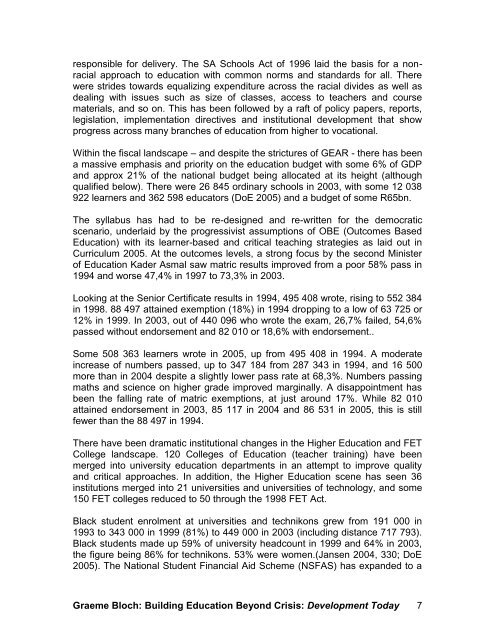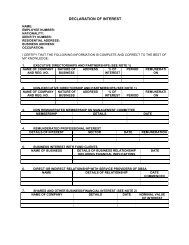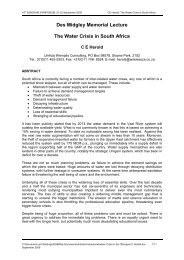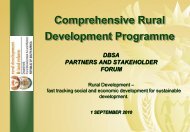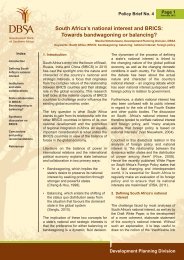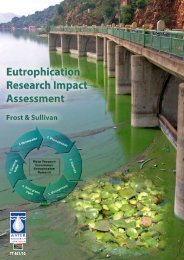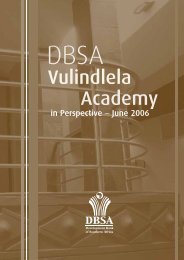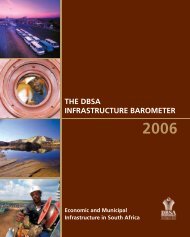Building education beyond crisis.pdf
Building education beyond crisis.pdf
Building education beyond crisis.pdf
Create successful ePaper yourself
Turn your PDF publications into a flip-book with our unique Google optimized e-Paper software.
esponsible for delivery. The SA Schools Act of 1996 laid the basis for a nonracialapproach to <strong>education</strong> with common norms and standards for all. Therewere strides towards equalizing expenditure across the racial divides as well asdealing with issues such as size of classes, access to teachers and coursematerials, and so on. This has been followed by a raft of policy papers, reports,legislation, implementation directives and institutional development that showprogress across many branches of <strong>education</strong> from higher to vocational.Within the fiscal landscape – and despite the strictures of GEAR - there has beena massive emphasis and priority on the <strong>education</strong> budget with some 6% of GDPand approx 21% of the national budget being allocated at its height (althoughqualified below). There were 26 845 ordinary schools in 2003, with some 12 038922 learners and 362 598 educators (DoE 2005) and a budget of some R65bn.The syllabus has had to be re-designed and re-written for the democraticscenario, underlaid by the progressivist assumptions of OBE (Outcomes BasedEducation) with its learner-based and critical teaching strategies as laid out inCurriculum 2005. At the outcomes levels, a strong focus by the second Ministerof Education Kader Asmal saw matric results improved from a poor 58% pass in1994 and worse 47,4% in 1997 to 73,3% in 2003.Looking at the Senior Certificate results in 1994, 495 408 wrote, rising to 552 384in 1998. 88 497 attained exemption (18%) in 1994 dropping to a low of 63 725 or12% in 1999. In 2003, out of 440 096 who wrote the exam, 26,7% failed, 54,6%passed without endorsement and 82 010 or 18,6% with endorsement..Some 508 363 learners wrote in 2005, up from 495 408 in 1994. A moderateincrease of numbers passed, up to 347 184 from 287 343 in 1994, and 16 500more than in 2004 despite a slightly lower pass rate at 68,3%. Numbers passingmaths and science on higher grade improved marginally. A disappointment hasbeen the falling rate of matric exemptions, at just around 17%. While 82 010attained endorsement in 2003, 85 117 in 2004 and 86 531 in 2005, this is stillfewer than the 88 497 in 1994.There have been dramatic institutional changes in the Higher Education and FETCollege landscape. 120 Colleges of Education (teacher training) have beenmerged into university <strong>education</strong> departments in an attempt to improve qualityand critical approaches. In addition, the Higher Education scene has seen 36institutions merged into 21 universities and universities of technology, and some150 FET colleges reduced to 50 through the 1998 FET Act.Black student enrolment at universities and technikons grew from 191 000 in1993 to 343 000 in 1999 (81%) to 449 000 in 2003 (including distance 717 793).Black students made up 59% of university headcount in 1999 and 64% in 2003,the figure being 86% for technikons. 53% were women.(Jansen 2004, 330; DoE2005). The National Student Financial Aid Scheme (NSFAS) has expanded to aGraeme Bloch: <strong>Building</strong> Education Beyond Crisis: Development Today 7


